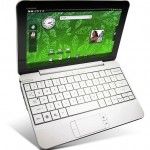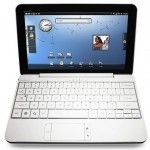I’m not one to let companies hide the real price of a device behind a subscription but at the moment I can’t find the full, unsubsidised price of the ARM/Android-based HP Compaq Airlife 100 that has just launched in Spain. Based on the two prices below and similar subsidy deals, the full price if the Airlife looks to be about 450 Euros. It sounds expensive for a smartbook doesn’t it but it’s not. A 3G-capable ‘smart’ book (I’m calling them ‘social netbooks’ to avoid the wrath of the company that sits about 30km from my office here in Germany) with GPS and a 12-hour battery life weighing 800gm do not exist in the market. This is unique and exciting. If I could order one today, I would. (Here’s why)
The full press release:
Telefonica has launched HP’s Compaq AirLife 100 netbook in Spain. The device features a 10.1-inch diagonal screen, a full keyboard, 16 GB solid state internal storage, SD card slot, Android operating system and customised touch interface. The netbook also features 3G access, Wi-Fi connectivity, VGA webcam, up to 12 hours of battery life in active use and up to 10 days of standby time, GPS capabilities, preinstalled NDrive navigation software with included regional maps with points of interest, and Qualcomm’s Snapdragon QSD8250 chipset platform. Telefonica will offer the Compaq AirLife 100 netbook at Movistar stores across Spain for EUR 230, in combination with Movistar’s Internet Maxi data plan with a monthly fee of EUR 49.
Customers can also acquire the HP netbook for EUR 300 along with Movistar’s Internet Plus data plan with a monthly fee of EUR 39.
I’m trying to get hold of availability info and of course, a review device and will update you when I have more information. In the meantime, see the specifications, gallery, videos and related links in the Airlife 100 information page.
Via Telecompaper














HP Airlife 100 is a brilliant Android laptop with a nice resistive touch screen. It’s definitely a good example of where the market is heading:
– Engineers making Airlife 100 are very talented and they really put a lot of work customizing Android for laptop form factor.
– HP may or may not yet fully invest its sales and marketing in this form factor. One question is how much would HP want to invest in Android development now that they bought WebOS with Palm for $1.2 Billion. I think the best would be for HP to merge what they think is best from WebOS into their own version of Android.
– The 229€ subsidized price is obviously not as cheap as this type of device should be. It surely should be sold below 200€ unsubsidized once it is mass manufactured. But given this is the first such product on the market, they may think they can try to optimize margins.
– It being only released in Spain is weird, but normally they are releasing in the rest of Europe and USA soon. As carriers make deals for it.
– A swivel screen form factor would probably had been best, thus turning the form factor into a true Android powered iPad competitor.
– Of course, Pixel Qi LCD with capacitive touch would have been best. It would increase battery life by 5x and made it really usable outdoors, and especially usable for reading a lot of text and using it as an A4 sized e-reader with stylus annotations feature.
Anyways, it’s going to be great fun to see these devices come to the market, and no reason HP isn’t working hard on Airlife 101 already.